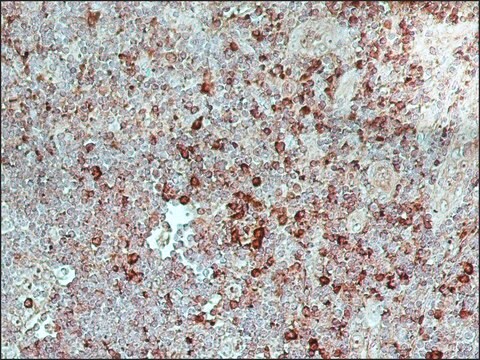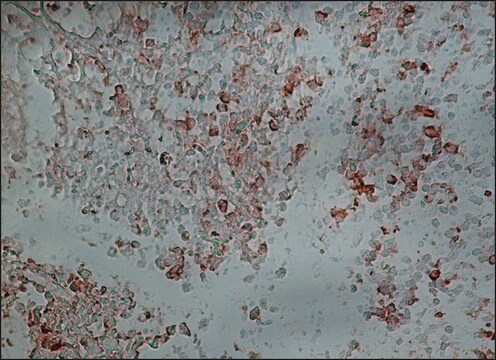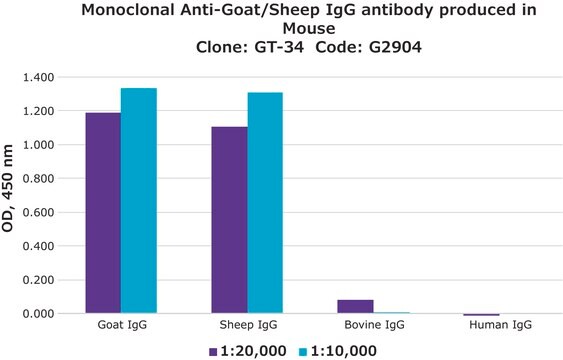AP147P
Rabbit Anti-Sheep IgG Antibody, HRP conjugate
Chemicon®, from rabbit
Sign Into View Organizational & Contract Pricing
All Photos(1)
About This Item
UNSPSC Code:
12352203
eCl@ss:
32160702
NACRES:
NA.46
Recommended Products
biological source
rabbit
Quality Level
conjugate
peroxidase conjugate
antibody form
affinity purified immunoglobulin
antibody product type
secondary antibodies
clone
polyclonal
species reactivity
sheep
manufacturer/tradename
Chemicon®
technique(s)
ELISA: suitable
western blot: suitable
shipped in
wet ice
target post-translational modification
unmodified
General description
Affinity purified rabbit anti-sheep IgG, Peroxidase conjugated
Immunoglobulin G (IgG), is one of the most abundant proteins in human serum with normal levels between 8-17 mg/mL in adult blood. IgG is important for our defence against microorganisms and the molecules are produced by B lymphocytes as a part of our adaptive immune response. The IgG molecule has two separate functions; to bind to the pathogen that elicited the response and to recruit other cells and molecules to destroy the antigen. The variability of the IgG pool is generated by somatic recombination and the number of specificities in an individual at a given time point is estimated to be 1011 variants.
Application
EIA and Western blots: 1:5,000-1:100,000.
Immunohistochemistry: 1:500-1:5,000.
Optimal working dilutions must be determined by end user.
Immunohistochemistry: 1:500-1:5,000.
Optimal working dilutions must be determined by end user.
Research Category
Secondary & Control Antibodies
Secondary & Control Antibodies
Research Sub Category
Whole Immunoglobulin Secondary Antibodies
Whole Immunoglobulin Secondary Antibodies
This Rabbit anti-Sheep IgG Antibody, HRP conjugate is validated for use in ELISA, WB for the detection of Sheep IgG.
Physical form
ImmunoAffinity Purified
RECONSTITUTION:
Reconstitute with 1.5 mL of sterile distilled water.
Reconstitute with 1.5 mL of sterile distilled water.
Storage and Stability
STORAGE: Maintain lyophilized product at 2-8°C for up to 12 months. After reconstitution the product is stable for several weeks at 2-8°C as an undiluted liquid. For extended storage after reconstitution, add an equal volume of glycerol to make a final concentration of 50% glycerol followed by storage at -20°C in undiluted aliquots for up to 12 months. Please note the concentration of protein (and buffer salts) will decrease to one-half of the original after the addition of glycerol. Avoid repeated freeze/thaw cycles.
WARNING:
Use of sodium azide as a preservative will substantially inhibit the enzyme activity of HRP.
WARNING:
Use of sodium azide as a preservative will substantially inhibit the enzyme activity of HRP.
Legal Information
CHEMICON is a registered trademark of Merck KGaA, Darmstadt, Germany
Disclaimer
Unless otherwise stated in our catalog or other company documentation accompanying the product(s), our products are intended for research use only and are not to be used for any other purpose, which includes but is not limited to, unauthorized commercial uses, in vitro diagnostic uses, ex vivo or in vivo therapeutic uses or any type of consumption or application to humans or animals.
Not finding the right product?
Try our Product Selector Tool.
Storage Class Code
13 - Non Combustible Solids
WGK
WGK 3
Flash Point(F)
Not applicable
Flash Point(C)
Not applicable
Certificates of Analysis (COA)
Search for Certificates of Analysis (COA) by entering the products Lot/Batch Number. Lot and Batch Numbers can be found on a product’s label following the words ‘Lot’ or ‘Batch’.
Already Own This Product?
Find documentation for the products that you have recently purchased in the Document Library.
Customers Also Viewed
Kim Kirby et al.
The Journal of biological chemistry, 283(51), 35393-35401 (2008-10-25)
Copper,zinc superoxide dismutase (SOD1) in mammals is activated principally via a copper chaperone (CCS) and to a lesser degree by a CCS-independent pathway of unknown nature. In this study, we have characterized the requirement for CCS in activating SOD1 from
Flavia Ferrantelli et al.
International journal of nanomedicine, 14, 8755-8768 (2019-12-07)
Single-chain variable fragments (scFvs) are one of the smallest antigen-binding units having the invaluable advantage to be expressed by a unique short open reading frame (ORF). Despite their reduced size, spontaneous cell entry of scFvs remains inefficient, hence precluding the
Hanne M Hoffmann et al.
Addiction biology, 17(3), 565-575 (2011-08-05)
Cocaine abuse leads to adaptations in brain reward circuits, where dopaminergic neurotransmission is a fundamental component. We hypothesized that chronic cocaine self-administration could influence dopamine D1 and D2 receptor activation of extracellular signal-regulated protein kinase 1 and 2 (ERK1/2) and
Wen Jing et al.
Oncology letters, 20(6), 309-309 (2020-10-24)
Most patients with advanced leukemia eventually die from multidrug resistance (MDR). Chemotherapy-resistant leukemia cells may lead to treatment failure and disease relapse. Overexpression of ATP-binding cassette subfamily G member 2 (ABCG2) leads to MDR, which serves as a potential biomarker
Robert Root-Bernstein et al.
Autoimmunity, 42(1), 1-16 (2008-07-09)
A variety of clinical, epidemiological, and experimental data suggest that rheumatic heart disease and autoimmune myocarditis are not only similar in their pathogenesis, but may often be due to combined infections with coxsackie virus (CX) and streptococcus A bacteria (SA).
Our team of scientists has experience in all areas of research including Life Science, Material Science, Chemical Synthesis, Chromatography, Analytical and many others.
Contact Technical Service





